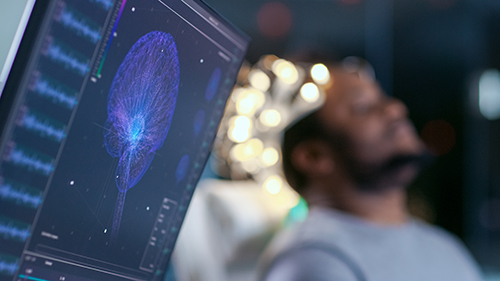Pathophysiology and Risk Factors
Parkinsonism is a clinical syndrome presenting with any combination of bradykinesia (slow movement), resting tremor, rigidity and postural instability. The underlying pathophysiology of PD is the progressive degeneration of dopamine-producing neurons, causing decreased production of the neurotransmitter dopamine in the basal ganglia (found in the midbrain). This leads to the overactivation and underactivation of pathways that control movement, with an overall effect of motor cortex suppression, which then manifests as paucity and slowness of movement. Therefore, the primary treatment of PD is to increase dopamine and to stimulate areas of the brain to counteract the abnormal function of these pathways. In addition, as the dopamine depletion progresses, other parts of the brain (the brainstem, thalamus, and cerebral cortex) as well as other neurotransmitters (glutamate, GABA, and serotonin) are affected, leading to additional neurological signs and symptoms.
Both environmental and hereditary factors are thought to trigger the younger onset of PD, although the definitive etiology of YOPD is not yet known. The higher incidence of YOPD in Asia has been attributed to genetic factors along with environmental exposure. Although causation is not well established, there are studies that have associated rural living, well water drinking, herbicide and pesticide exposure, and proximity to industry as risk factors for the disease. Substantial exposure to environmental toxins leads to rapid degeneration of dopamine neurons and is presumed to be responsible for the development of PD at an early age.2 These environmental exposures may lead to the development of disease in someone who has a genetic susceptibility. In particular, the dominant genes SNCA, LRRK2, GBA, VPS35 and recessive genes Parkin, PINK1, DJ1 have been implicated.6 Typically, those with juvenile-onset parkinsonism (less than 21 years old) are more likely to have an underlying familial or genetic cause.
Diagnosis and Clinical Manifestations
The diagnosis of PD is clinical: classic manifestations of PD consist of resting tremor, rigidity, bradykinesia, and gait instability. A positive response to medication trials of PD therapy is also considered supportive of the diagnosis. Ancillary tests, used to rule out alternative diagnoses, include neuroimaging such as magnetic resonance imaging (MRI), DaTscan (an imaging study in which radioactive tracer, ioflupane, is injected into the blood and attaches to the dopamine transporter), positron emission tomography (PET) and transcranial ultrasound.
The symptoms that appear in YOPD resemble the classical symptoms of LOPD; however, YOPD often begins with dystonia, an uncontrollable stiffness or cramping of a muscle group or limb.2 In addition to dystonia, levodopa-induced dyskinesias are more common in YOPD than in LOPD.6 Nonmotor symptoms include sleep disturbances, cognitive impairment, and urinary and sexual dysfunction. Cognitive impairment in PD ranges from subtle deficits to frank dementia. In a small study comparing those with YOPD and LOPD, those with YOPD performed better in cognitive assessment testing in comparison to those with LOPD, with patients with mild motor impairments scoring higher than those with moderate to severe impairments.7
Lastly, some studies have shown that depression and anxiety are more prevalent in those with YOPD in comparison to individuals with LOPD. Whether this is causal or a downstream implication of the early onset of the disease is unclear. Societal factors are contributory, as those with YOPD tend to still be working, forming relationships, have young children, or may be considering pregnancy.6
Treatment
Currently there is no known cure for Parkinson’s disease. However, certain therapies may help in reducing symptoms. The treatment of YOPD is unique for each individual and can require repeated adjustments of multiple medications. Initially, YOPD patients are most often treated with levodopa or its alternatives. Levodopa (L-dopa or LD) is converted to dopamine and is the main treatment for both LOPD and YOPD. Other treatments for YOPD include MAO-B inhibitors, catechol-O-methyltransferase inhibitors, amantadine and dopamine agonists. MAO-B helps limit the breakdown of dopamine in the brain, while catechol-O-methyltransferase helps extend levodopa’s effects on the brain. Amantadine may be added to help with muscle control and stiffness. Dopamine agonists, commonly known under the brand names Requip and Mirapex, help stimulate dopamine receptors and have been shown to be about as effective as levodopa in treating mild-to-moderate PD.8
One of the most important treatments for YOPD is daily movement and exercise. Almost all research on YOPD and LOPD indicates that maintaining regular physical activity and exercise improves mobility, flexibility and balance. There may also be a secondary effect at easing non-motor symptoms such as depression or constipation.9 Some of the most popular exercises include exaggerated movements to help with hand-eye and brain coordination, strength training, aerobic exercise, stretching and non-contact boxing.
Because a person with YOPD is likely still working, occupational therapy is also considered important and often put into the same classification of treatment as exercise. It is important that someone with YOPD learn daily techniques and tips to help them continue to contribute and be productive in their field of work. Occupational therapy combined with daily movement and exercise is highly recommended to prevent progression of the disease.
In terms of surgical intervention, a well-known treatment for YOPD is deep brain stimulation (DBS). Initially approved by the U.S. Food and Drug Administration (FDA) in 1997 to treat Parkinson’s tremor, it was subsequently used as treatment in 2002 for more advanced Parkinson’s symptoms. In 2016 it was presented as a surgical option for YOPD patients who have been diagnosed for at least 4 years and who continue to be symptomatic despite medication.9 DBS is most effective for people who experience disabling tremors, wearing-off spells (i.e., when the effectiveness of levodopa wears off prior to the next scheduled dose, resulting in the return of symptoms) and medication-induced dyskinesias. Electrodes are inserted into a targeted area of the brain using MRI and a second procedure is performed to implant an impulse generator battery (IPG), similar to a heart pacemaker and approximately the size of a stopwatch.9 A less invasive surgical option is called Duopa therapy. It is a form of carbidopa-levodopa delivered directly into the intestine in gel form rather than a pill. This is designed to improve absorption by delivering the drug directly to the small intestine.9 Other treatment options for YOPD include the non-invasive focused ultrasound which emits sound waves into the brain to create high energy and heat, thus destroying specific areas in the brain that are associated with the tremor.9 Less common procedures include thalamotomy, subthalamotomy and pallidotomy, in which a lesion is performed surgically on the thalamus, globus pallidus and subthalamus, respectively, to reduce symptoms.
Prognosis and Mortality/Morbidity Implications
A study using the Swedish National Registry for PD found that a lower age of onset was associated with slower progression of motor symptoms.10 In general, individuals with YOPD have less comorbidity, slower disease progression, less frequent gait disturbances, as well as delayed falls, freezing and delayed cognitive decline compared to those with LOPD.11
Cognitive dysfunction has been found to progress more slowly in those with YOPD.12 A study of older PD patients (mean age of 72.1) found that survival in those with normal cognition at baseline was 11.6 years, not significantly different from the general population, in comparison to 8.6 years in those with a diagnosis of mild cognitive impairment.13
Mortality data reveal varying results in those with YOPD. Early research of 54 patients found that younger age of onset was associated with a more favorable prognosis than an older age of presentation, with the YOPD group showing the most favorable observed-to-expected mortality ratio of 1.82, as compared to 2.17 for those with an onset of symptoms at between the ages of 50 to 59, and 2.20 for those who were 60 and older. However, the difference was not statistically significant.14 Another study of 129 patients with YOPD revealed a mortality risk that was double the general population and comparable to the overall PD population, with poor response to L-dopa identified as a risk factor for early death. Cognitive impairment was found in only 19% of YOPD patients as compared to 43% in the LOPD patients.15
In contrast, a longitudinal study from Norway followed a cohort of 587 patients with both LOPD and YOPD from 1997 to 2020.16 The overall cohort mortality was more than two times higher than expected in comparison to whole population mortality. It was found that those with normal cognition had improved survival. The YOPD group, accounting for 12% of the whole cohort, lived for a longer period of time in absolute terms than older patients; however, the mortality in the PD cohort with age of onset of 20-39 years (17 patients) was more than five times higher than expected. Cause of death information was available for 51 people in the YOPD group. PD was identified as the underlying cause of death in 39%, while the rest were due to cardiovascular and cerebrovascular disease, neoplasms, pneumonia, external factors and other causes.16
Studies have shown that individuals with YOPD exhibit a slower progression of both motor and cognitive impairment than those with LOPD, and that cognitive impairment is strongly associated with mortality. Overall mortality for those with PD across all ages has been found to be approximately double the general population, with a recent study demonstrating that mortality to be far higher than expected in those who have YOPD. Given the lack of large-scale, long-term data on the mortality of YOPD, further research is needed to provide a deeper understanding of disease course and prognosis.






